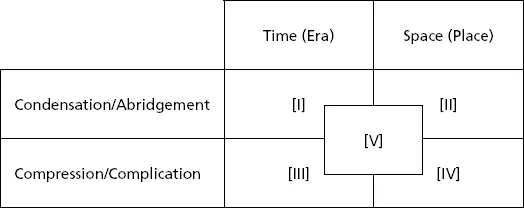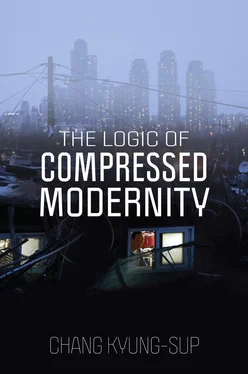As pointed out in Chapter 10, “The Post-Compressed Modern Condition,” South Korea’s “miraculous” achievement of modernization and development has not exempted the country from what Ulrich Beck explained as the risks of “second modernity” – namely, the inherent dysfunctions and increasing failures of modern institutions such as capitalist industry, labor market, education system, science and technology, national government, middle-class family, and so forth. While these onerous risks are only now recognized, South Koreans are struggling with additional predicaments derived from the particular measures and processes of their compressed modernization and development. Conversely, at the very historical moment that South Korean society should embark on fundamentally redressing the costs of such risky measures of compressed social and economic transformations, its people are confronted with the globally common prices to be paid at the supposedly mature stage of development and modernization. This is South Korea’s post-compressed modern condition, which appears no less challenging than its immediate post-colonial condition plagued with poverty and hunger, political rifts, and social conflicts and dislocations.
1 1. Statistical indicators in this paragraph are fully presented in “Compressed Modernity in South Korea” (Chang, K. 2016a).
2 2. Republic of Korea Policy Briefing, February 27, 2019 ( http://www.korea.kr/news/policyBriefingView.do?newsId=156319329).
3 3. Particularly notable scholars in this respect include: Amsden (1989) and Lim, H. (1986) on developmental governance, Koo, H. (2001) on working-class formation (2001), Choi, J. (2002) on democratization (2002), Abelmann (2003) on gender and class, Cumings (1981) on postcolonial politics, Moon, S. (2012) and Eckert (2016) on sociopolitical militarism and so forth.
4 4. For instance, a most consistent effort in this respect has been made by Shin Yong-Ha (1994), a historical sociologist whose intellectual leadership has been critical in the formation of an influential academic school that underscores indigenous historical and sociocultural conditions for contemporary social phenomena.
5 5. By nature, the contemporary Korean popular songs, called “the K-pop,” may be less explicit in such socially discursive engagement. However, the completely globalized esteem of the BTS (Bangtansonyeondan), a latest epitome in this genre, has been substantially based upon its social messages and approaches.
6 6. The South Korean government has an explicit academic policy of promoting the “international mainstreaming” of national social sciences and overseas Korean studies on the basis of Korean realities and experiences. While its scientific effect yet remains dubious, the Korean wave has certainly helped to promote the transnational popular appreciation of Korean culture, society, and history – not to mention, to the liking of the government, technocracy and likeminded media. On the part of most cultural producers, there are conscious efforts to maintain at least an arm’s length distance from such a potentially nationalist, if not chauvinistic, position.
7 7. Also, contemporary Vietnamese society is increasingly analyzed as another instance of post-socialist compressed modernity. In such studies on China and Vietnam, a possible convergence between post-socialist and late capitalist paths to modernization and development is implicitly suggested in terms of their common compressed modernity.
8 8. Harvey might be regarded as suggesting a sort of global-scale compressed modernity as a distinctive stage of (both modern and postmodern) capitalism. This stage has been further accentuated by global neoliberalism since the 1980s, largely through the same logic and/or crisis of capitalism. Besides, Harvey’s work seems to serve as an indispensable precursor to the so-called cosmopolitan turn of sociology led by Ulrich Beck (see Beck and Sznaider 2006), etc.
9 9. Before the intellectual ascendance of postcolonialism, many sociologists, such as S. N. Eisenstadt (2000), and Paget Henry (Henry and Walter 1995) had pointed out extensive hybridization between indigenous (traditional) and Western (modern) cultures in various instances of late modernization.
10 10. If postcolonialist literature and scholarship, to the extent that they intellectually and politically represent postcolonial societies or peoples themselves, are taken as social phenomena, it may be said that fundamental transcendence over the West is not entirely absent. For instance, Dipesh Chakrabarty’s (1992) critique of (Western) academic history as well as Edward Said’s (1978) critique of (Western) literature has not only transcended the epistemological constraints consciously or unconsciously imposed by the West on non-Western (at least by birth) minds but also helped enlighten Western minds about history, morality, and aesthetics.
2 COMPRESSED MODERNITY Constitutive Dimensions and Manifesting Units
2.1 Introduction
In a globally grounded comparative modernity approach, this chapter presents the formal definition, core theoretical components, and historical conditions of compressed modernity. This approach draws insights from various critical debates on complex and murky social realities in the late modern world, including postmodernism (e.g. Lyotard 1984), postcolonialism (e.g. Chakrabarty 2000), reflexive modernization (Beck, Giddens, and Lash 1994), and multiple and entangled modernities (Eisenstadt 2000; Therborn 2003). As broadly examined in the previous chapter, all of these critical debates on modernity have essential implications for the compressed modernity thesis. Compressed modernity is a critical theory of postcolonial social change, aspiring to join and learn from these critical intellectual reactions to modernity and its degenerative variations.
Compressed modernity is a civilizational condition in which economic, political, social and/or cultural changes occur in an extremely condensed manner with regard to both time and space, and in which the dynamic coexistence of mutually disparate historical and social elements leads to the construction and reconstruction of a highly complex and fluid social system (Chang, K. 2017a). Compressed modernity, as detailed subsequently, can be manifested at various levels of human existence and experience – that is, personhood, family, secondary organizations, urban/rural localities, societal units (including civil society, nation, etc.), and, not least importantly, the global society. At each of these levels, people’s lives need to be managed intensely, intricately, and flexibly in order to remain normally integrated with the rest of society.

Figure 2.1 The five constitutive dimensions of compressed modernity
Figure 2.1 shows that compressed modernity is composed of five specific dimensions that are constituted interactively by the two axes of time/space and condensation/compression. The time facet includes both physical time (point, sequence, and amount of time) and historical time (era, epoch, and phase). The space facet includes physical space (location and area) and cultural space (place and region). As compared to physically standardized abstract time–space, era–place serves as a concrete framework for constructing and/or accommodating an actually existing civilization. 1Condensation/Abridgement refers to the phenomenon that the physical process required for the movement or change between two time points (eras) or between two locations (places) is abridged or compacted (Dimensions [I] and [II] respectively). Compression/Complication refers to the phenomenon that diverse components of multiple civilizations that have existed in different eras and/or places coexist in a certain delimited time–space and influence and change each other (Dimensions [III] and [IV] respectively). The phenomena generated in these four dimensions, in turn, interact with each other in complicated ways and further generate different social phenomena (Dimension [V]).
Читать дальше













